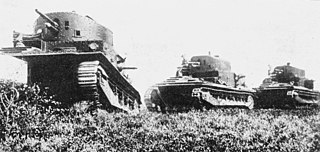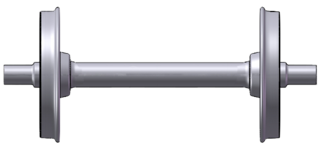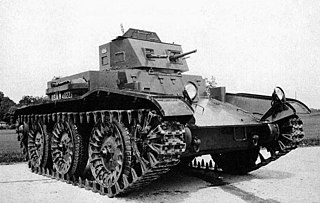
A bogie is a chassis or framework that carries a wheelset, attached to a vehicle—a modular subassembly of wheels and axles. Bogies take various forms in various modes of transport. A bogie may remain normally attached or be quickly detachable. It may include a suspension component within it, or be solid and in turn be suspended ; it may be mounted on a swivel, as traditionally on a railway carriage or locomotive, additionally jointed and sprung, or held in place by other means.

DAF Trucks is a Dutch truck manufacturing company and a division of Paccar. DAF originally stood for van Doorne's Aanhangwagen Fabriek. Its headquarters and main plant are in Eindhoven. Cabs and axle assemblies are produced at its Westerlo plant in Belgium. Some of the truck models sold with the DAF brand are designed and built by Leyland Trucks at its Leyland plant in the United Kingdom.

An amphibious vehicle is a vehicle that works both on land and on or under water. Amphibious vehicles include amphibious bicycles, ATVs, cars, buses, trucks, railway vehicles, combat vehicles, and hovercraft.

Suspension is the system of tires, tire air, springs, shock absorbers and linkages that connects a vehicle to its wheels and allows relative motion between the two. Suspension systems must support both road holding/handling and ride quality, which are at odds with each other. The tuning of suspensions involves finding the right compromise. It is important for the suspension to keep the road wheel in contact with the road surface as much as possible, because all the road or ground forces acting on the vehicle do so through the contact patches of the tires. The suspension also protects the vehicle itself and any cargo or luggage from damage and wear. The design of front and rear suspension of a car may be different.

Variomatic is the continuously variable transmission (CVT) of the Dutch car manufacturer DAF, originally developed by Hub van Doorne. It is a stepless, fully-automatic transmission, consisting of a V-shaped drive-belt, and two pulleys, each of two cones, whose effective diameter can be changed so that the "V" belt runs nearer the spindle or nearer the rim, depending on the separation of the cones. These are synchronized so that the belt always remains at the same optimal tension.

A de Dion axle is a form of non-independent automobile suspension. It is a considerable improvement over the swing axle, Hotchkiss drive, or live axle. Because it plays no part in transmitting power to the drive wheels, it is sometimes called a "dead axle".

Horstmann suspension, also known as Horstman, Vickers-Horstman and rarely Slow Motion, is a type of tracked suspension devised by British tank designer John Carden and worked into a production design by engineer Sidney Horstmann.

The Schofield tank, named after its designer, was a New Zealand tank design of the Second World War. Developed in 1940 when it seemed that the Pacific War might reach New Zealand and with little likelihood of weapons coming from Britain, it did not enter service. It was designed to run on either tracks or wheels.

The Vickers Medium Mark I was a British tank of the Inter-war period built by Vickers from 1924.

A magnetic track brake is a brake for rail vehicles. It consists of brake magnets, pole shoes, a suspension, a power transmission and, in the case of mainline railroads, a track rod. When current flows through the magnet coil, the magnet is attracted to the rail, which presses the pole shoes against the rail, thereby decelerating the vehicle.

The Renault UE Chenillette is a light tracked armoured carrier and prime mover produced by France between 1932 and 1940.

The Lorraine 37L or Tracteur de ravitaillement pour chars 1937 L, is a light tracked armoured vehicle developed by the Lorraine company during the interwar period or interbellum, before the Second World War, to an April 1936 French Army requirement for a fully armoured munition and fuel supply carrier to be used by tank units for front line resupply. A prototype was built in 1937 and production started in 1939. In this period, two armoured personnel carriers and a tank destroyer project were also based on its chassis. Mainly equipping the larger mechanised units of the French Infantry arm, the type was extensively employed during the Battle of France in 1940. After the defeat of France, clandestine manufacture was continued in Vichy France, culminating in a small AFV production after the liberation and bringing the total production to about 630 in 1945. Germany used captured vehicles in their original role of carrier and later, finding the suspension system to be particularly reliable, rebuilt many into tank destroyers of the Marder I type or into self-propelled artillery.

A wheelset is a pair of railroad vehicle wheels mounted rigidly on an axle allowing both wheels to rotate together. Wheelsets are often mounted in a bogie – a pivoted frame assembly holding at least two wheelsets – at each end of the vehicle. Most modern freight cars and passenger cars have bogies each with two wheelsets, but three wheelsets are used in bogies of freight cars that carry heavy loads, and three-wheelset bogies are under some passenger cars. Four-wheeled goods wagons that were once near-universal in Europe and Great Britain and their colonies have only two wheelsets; in recent decades such vehicles have become less common as trainloads have become heavier.

An articulated hauler, articulated dump truck (ADT), or sometimes a dump hauler, is a very large heavy-duty type of dump truck used to transport loads over rough terrain, and occasionally on public roads. The vehicle usually has all-wheel drive and consists of two basic units: the front section, generally called the tractor, and the rear section that contains the dump body, called the hauler or trailer section. Steering is made by pivoting the front in relation to the back by hydraulic rams. This way, all wheels follow the same path, making it an excellent off-road vehicle.

The Pantserwagen M39 or DAF Pantrado 3 was a Dutch 6×4 armoured car produced in the late 1930s for the Royal Dutch Army.

Eight-wheel drive, often notated as 8WD or 8×8, is a drivetrain configuration that allows all eight wheels of an eight-wheeled vehicle to be drive wheels simultaneously. Unlike four-wheel drive drivetrains, the configuration is largely confined to heavy-duty off-road and military vehicles, such as armored vehicles, tractor units or all-terrain vehicles such as the Argo Avenger.

T7 combat car was a prototype United States light tank design of the interwar period. It could run on rubber-tired wheels on roads or mount tracks for cross-country use. Although adequate in some areas, it lacked armament compared to contemporary vehicles and the project was cancelled after only one was built.

An H-drive drivetrain is a system used for heavy off-road vehicles with 6×6 or 8×8 drive to supply power to each wheel station.
The Wilton-Fijenoord Pantserwagen was a armoured car that was built by Wilton-Fijenoord in the Netherlands for the Royal Netherlands East Indies Army.


















